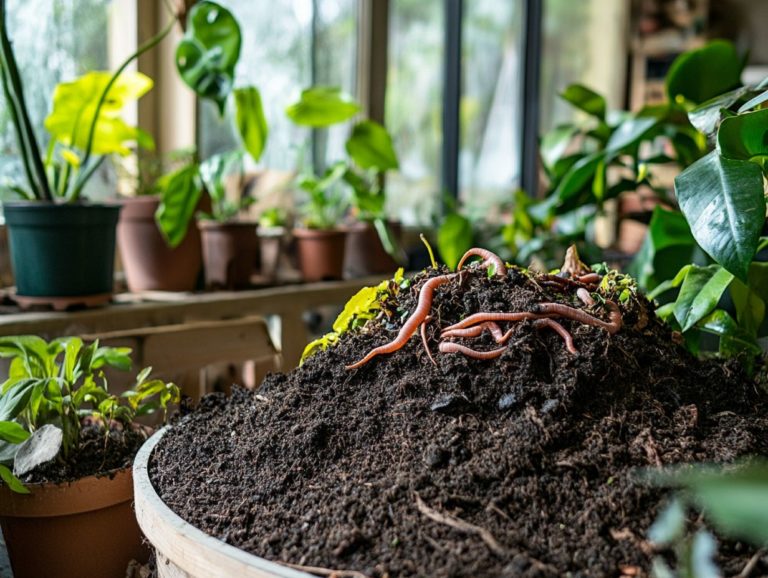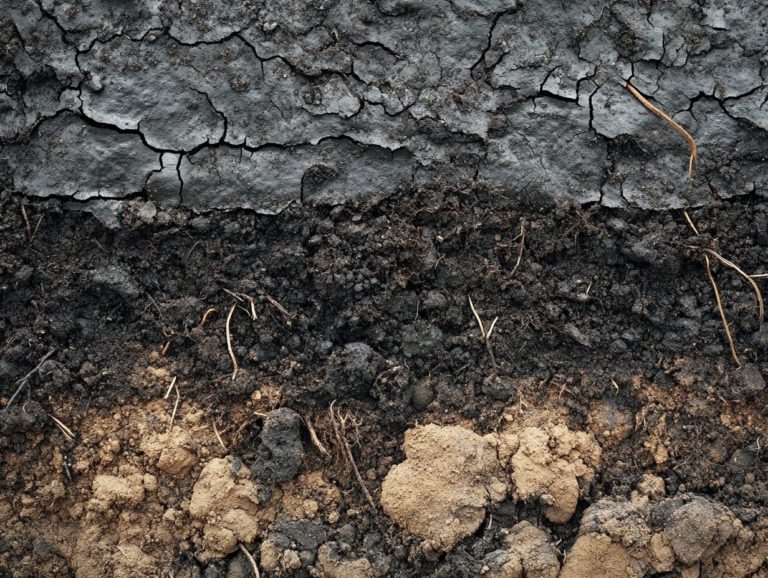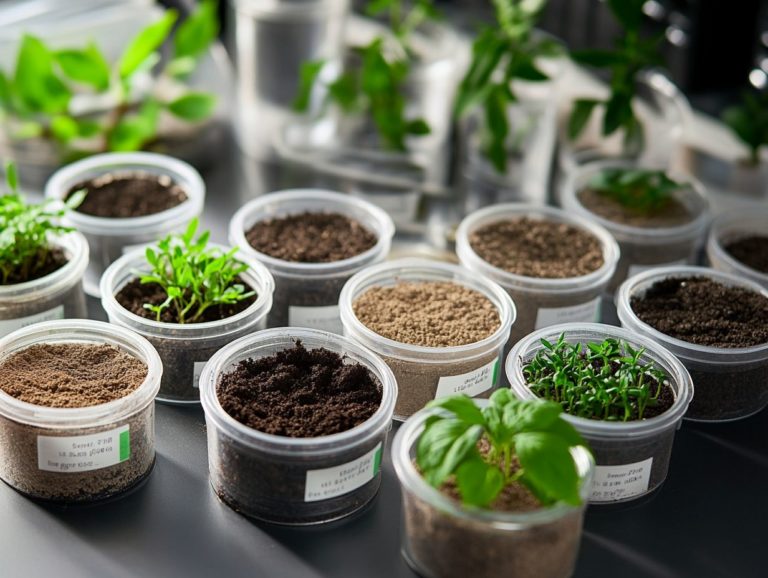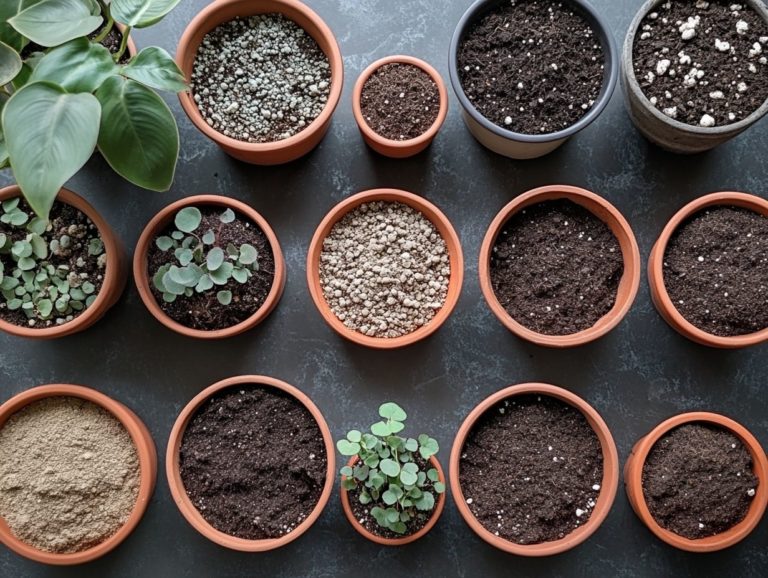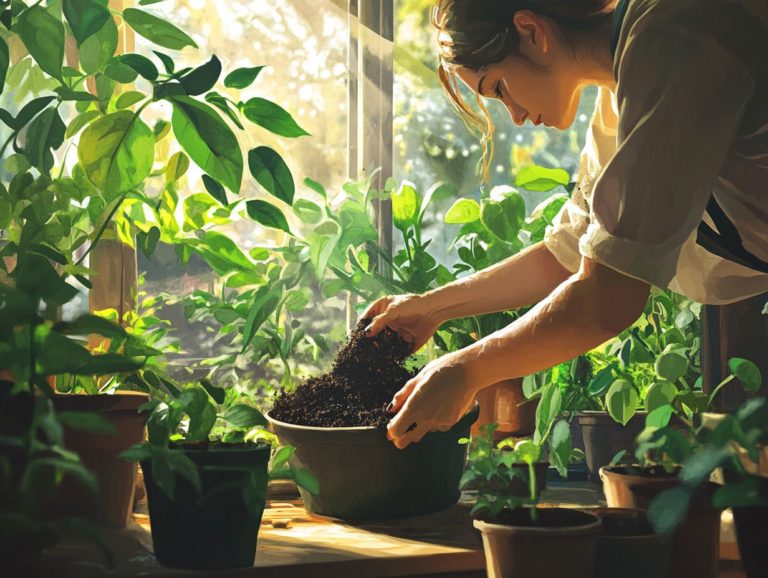5 Common Indoor Plant Soil Problems Solved
Indoor plants bring life and beauty to your space, yet maintaining their health can sometimes feel like a daunting task.
Understanding common soil problems is essential for nurturing your green companions. Whether it s overwatering, underwatering, nutrient deficiencies, or pests, each of these challenges can impede their growth.
This article delves into how to pinpoint these prevalent soil problems and provides practical solutions. Whether you re a seasoned plant enthusiast or a newcomer to the world of indoor gardening, you ll discover valuable tips to ensure your indoor garden flourishes.
Contents
- Key Takeaways:
- 1. Overwatering
- 2. Underwatering
- 3. Poor Drainage
- 4. Nutrient Deficiency
- 5. Pests and Diseases
- How to Identify and Fix These Soil Problems
- What Are the Signs of Overwatering and How to Correct It?
- What Are the Signs of Underwatering and How to Correct It?
- How to Improve Drainage in Indoor Plant Soil?
- What Are the Essential Nutrients for Indoor Plants and How to Provide Them?
- How to Prevent and Treat Common Pests and Diseases in Indoor Plants?
- Are There Any Natural Remedies for Soil Problems?
- How to Maintain Healthy Soil for Indoor Plants?
- What Are the Best Practices for Watering Indoor Plants?
- How Often Should Indoor Plants Be Repotted?
- What Are the Benefits of Using Organic Soil for Indoor Plants?
- How to Keep Indoor Plants Safe from Pets and Children?
- Frequently Asked Questions
- What are the 5 most common indoor plant soil problems?
- How can I tell if my plant’s soil is overwatered?
- What can I do if my plant’s soil is compacted?
- Can I use regular household soil for my indoor plants?
- How often should I fertilize my indoor plants?
- Why are my plant’s leaves yellow? Here s how to fix it!
Key Takeaways:
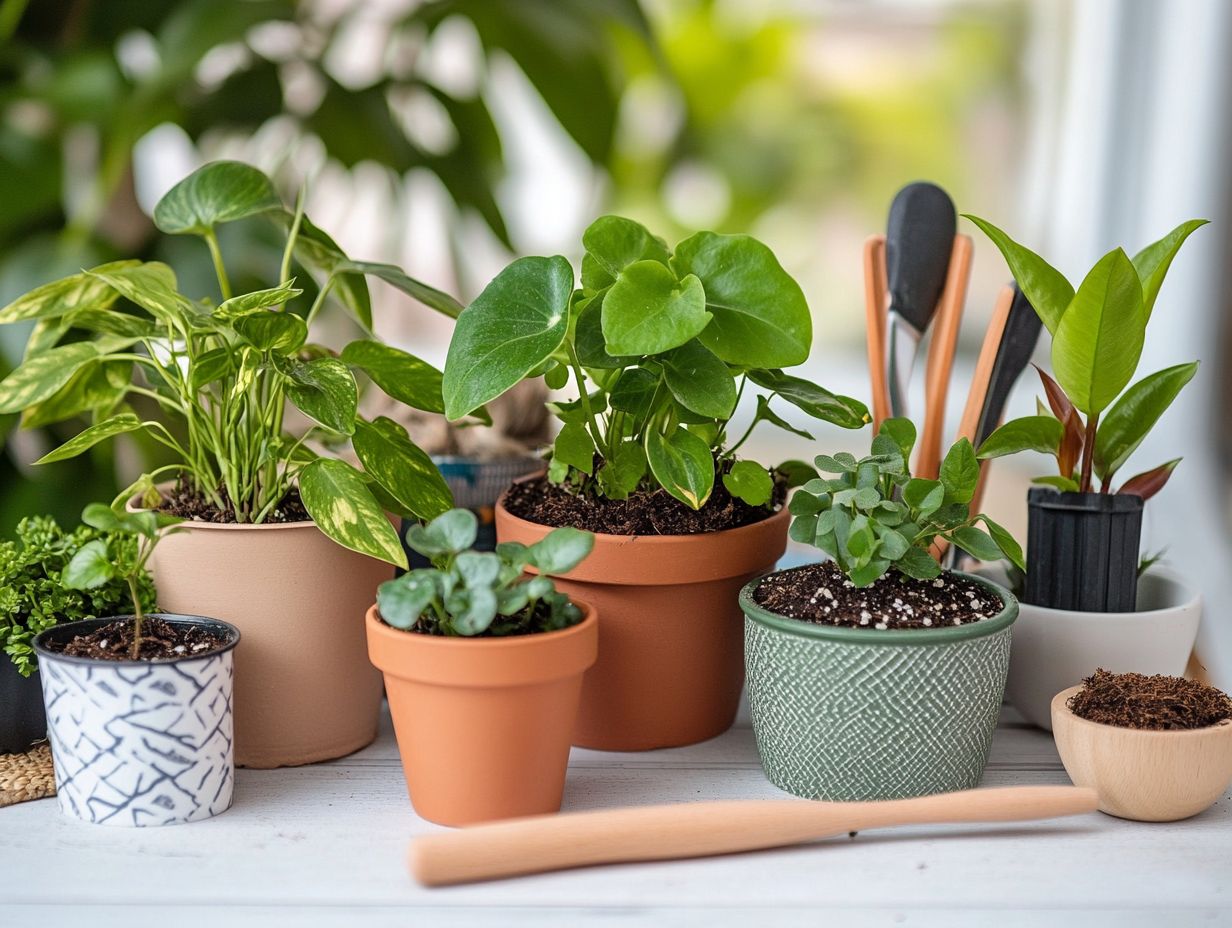
- Check the soil moisture regularly to avoid overwatering.
- Underwatering can cause wilting and yellowing of leaves. Water when the top inch of soil is dry.
- Poor drainage can be improved by adding perlite (a lightweight material that improves drainage) or sand to the soil mix and ensuring proper drainage holes in the pot.
1. Overwatering
Overwatering is a common struggle for many indoor plant enthusiasts. It can lead to a host of issues like yellowing leaves and root rot.
These problems can significantly impact the health of your cherished houseplants. Recognizing the signs of overwatering early on is vital for effective management and ensuring the longevity of your plants.
Several factors can contribute to overwatering, such as poor drainage and excessive humidity, both of which create a breeding ground for root issues. When soil remains soggy for extended periods, it deprives the roots of essential oxygen, ultimately resulting in decay.
Keep an eye out for symptoms like wilting, yellowing leaves, and a musty odor emanating from the soil.
To prevent these complications, it s crucial to:
- Select pots with drainage holes
- Amend your potting mix with materials that improve drainage
- Monitor humidity levels particularly during the wet season
By taking these proactive steps, you ll help maintain the vigor and vitality of the plants you hold dear.
2. Underwatering
Underwatering is a frequent challenge for those tending to houseplants. It often reveals itself through wilting leaves and leaf scorch clear signals that your indoor plants urgently crave moisture and attention.
Recognizing these signs early is essential, as prolonged underwatering can stunt growth or even lead to plant demise. If you observe the tips of your plant’s leaves turning brown and crispy, it’s a strong indication that water levels are alarmingly low.
To sidestep these problems, consider establishing a regular watering schedule that ensures moisture is evenly distributed throughout the soil. Using a moisture meter can also prove invaluable in identifying when your plants need a drink, allowing you to maintain their vitality without the stress of second-guessing their requirements.
3. Poor Drainage
Poor drainage is a pivotal aspect of your indoor plants’ health, as it can lead to serious issues like root rot. It’s essential to understand how to enhance soil drainage effectively.
When the soil retains excess water, it creates a suffocating environment for the roots, inhibiting oxygen absorption and encouraging fungal diseases.
Selecting the right type of pot is crucial; opting for pots with drainage holes allows excess water to escape, fostering a healthier root environment.
Using a well-aerated potting mix is crucial. Incorporating components such as perlite (a lightweight material that improves drainage) or coconut coir ensures that airflow and moisture retention are balanced. Regularly checking moisture levels and allowing the soil to dry out slightly between watering sessions will support a robust root system, ultimately leading to the thriving growth of your indoor plants. To ensure you’re using the right soil, refer to this guide on how to identify and treat soil of indoor plants.
4. Nutrient Deficiency
Nutrient deficiency is a major concern for indoor plants. It can lead to various common issues that undermine their growth and vitality if not addressed through proper fertilization.
Understanding essential nutrients like nitrogen, phosphorus, and potassium is important. Each nutrient is crucial for how plants make food, grow roots, and maintain overall health. When these nutrients are lacking, you may notice signs such as yellowing leaves or stunted growth, indicating an urgent need for supplementation.
Selecting the right fertilizer involves considering your plant s specific needs for a balanced nutrient profile. Formulations like slow-release fertilizers which gradually release nutrients over time or water-soluble fertilizers can promote steady growth. This allows your indoor plants to thrive and flourish in their environment with the care and attention they deserve.
5. Pests and Diseases
Pests and diseases pose a significant threat to indoor plants. They can lead to infestations that result in issues like powdery mildew, aphids, spider mites, and thrips. Prompt intervention and effective management strategies are necessary!
Common pests multiply rapidly, causing leaf discoloration and even the demise of your plants if not addressed. For example, aphids feed on your plant’s sap, draining its vitality. Spider mites weave fine webs that indicate their presence, highlighting the need for close monitoring of pest infestations. Be alert for early symptoms like yellowing leaves or sticky residue to swiftly identify issues.
To prevent these unwelcome visitors, maintain proper humidity and ensure adequate air circulation. Meticulously inspect any new plants before bringing them into your home, especially those from areas with known pest problems. If treatment becomes necessary, consider options like neem oil or insecticidal soap. Both are organic insecticides that effectively replace harsh chemicals.
How to Identify and Fix These Soil Problems
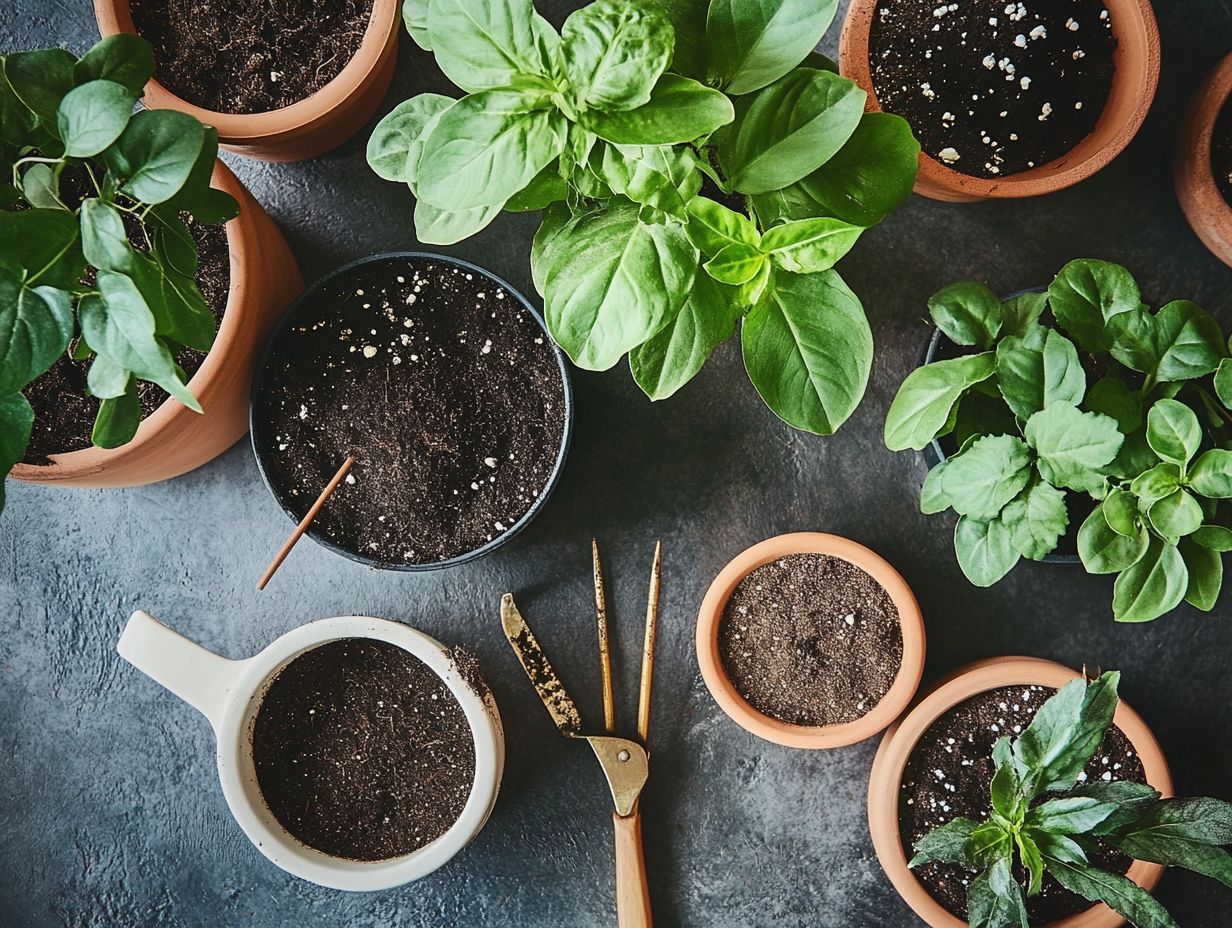
Identifying and addressing soil problems is essential for keeping your indoor plants thriving. Issues like overwatering, underwatering, nutrient deficiencies, and pest infestations can seriously impede their growth and vitality. Tailored solutions are necessary for effective plant care.
Recognizing signs of common soil-related problems is the first step toward ensuring your indoor greenery flourishes. By closely observing your plants, you can notice subtle changes in their health, such as wilting leaves or unusual yellowing, which may indicate an underlying soil issue. It’s also important to be aware of watering myths about indoor plants that can affect their care.
Acting on these concerns promptly is crucial for recovery and long-term health. This guide provides a clear roadmap for diagnosing common soil issues, complete with step-by-step solutions and preventative measures. With this knowledge, you’ll be well-equipped to cultivate lush, vibrant foliage while sidestepping the pitfalls of common myths about indoor plant soil and improper care!
What Are the Signs of Overwatering and How to Correct It?
Recognizing the signs of overwatering like yellowing leaves and root rot is essential for keeping your indoor plants healthy. This is particularly important when considering their specific humidity levels.
When you notice these symptoms, act quickly to rescue your greenery! Start by adjusting your watering schedule and allow the soil to dry out completely between sessions. This approach prevents the roots from sitting in overly damp conditions, especially if you’re using plants that thrive in clay soil.
Improving soil drainage can make a huge difference! Repot your plants using a well-draining mix and incorporate perlite for better aeration. Ensure your pots have adequate drainage holes to prevent water buildup, giving your plants the best chance to thrive by following the best practices for indoor plant soil care, even after past overwatering mishaps.
What Are the Signs of Underwatering and How to Correct It?
Understanding the signs of underwatering is crucial for anyone caring for houseplants. Wilting leaves and dry, crumbly soil are clear signals that your plant is thirsting for moisture. Timely interventions can breathe new life into your plants, restoring their health and ensuring their resilience against pests.
Recognizing these early indicators allows you to spring into action before more severe damage occurs, particularly in the context of disease management. Look out for yellowing leaves as well these symptoms indicate that your plant needs attention.
Act now to combat underwatering by setting up a solid watering routine! Regularly check the soil moisture levels using your finger or a moisture meter. To avoid issues, be aware of the 5 common mistakes in houseplant care and ensure the water penetrates deeply to encourage robust root growth, helping your leafy companions flourish.
How to Improve Drainage in Indoor Plant Soil?
Improving soil drainage for your indoor plants is vital to prevent root rot and ensure they thrive. Poor drainage can lead to significant health issues and stunted growth, especially when pest infestations are involved.
To achieve optimal soil drainage, use well-draining potting mixtures that allow excess water to escape while retaining necessary moisture. Choosing pots with drainage holes at the bottom is key for preventing water accumulation and ensuring your plants stay healthy.
Incorporating materials like perlite or vermiculite into your soil mix can enhance air circulation in the soil, promoting healthy root development. Master these techniques to create the ideal environment for your indoor greenery, ensuring they flourish vibrantly.
What Are the Essential Nutrients for Indoor Plants and How to Provide Them?
Providing essential nutrients to your indoor plants prevents nutrient deficiencies and maintains their overall health. This ensures they flourish and remain vibrant throughout the year.
Key nutrients include nitrogen for lush green foliage, phosphorus for strong root development and flowering, and potassium for overall resilience and disease resistance. Don t overlook calcium and magnesium, as they support cell wall structure and enzyme function.
Use a balanced fertilizer to support optimal growth. Feed your plants every 4-6 weeks during the growing season to keep them vibrant and healthy!
How to Prevent and Treat Common Pests and Diseases in Indoor Plants?
Preventing and treating common pests and diseases in your indoor plants is essential for their well-being. Guard against threats like powdery mildew, aphids, spider mites, and thrips that can spiral into serious infestations.
To tackle these issues, employ a mix of preventive measures and treatment options. Regular inspections of your plants for early signs of distress can help you catch problems before they escalate. Additionally, incorporating 5 essential soil care tips for indoor plants can help maintain optimal humidity levels, ensure adequate air circulation, and use appropriate watering techniques to diminish the risk of infestations.
When treatment becomes necessary, consider using organic insecticides made from natural ingredients. These can effectively target pests while minimizing environmental harm. You can also introduce beneficial insects, such as ladybugs or predatory mites, to nurture a healthier indoor ecosystem.
Are There Any Natural Remedies for Soil Problems?
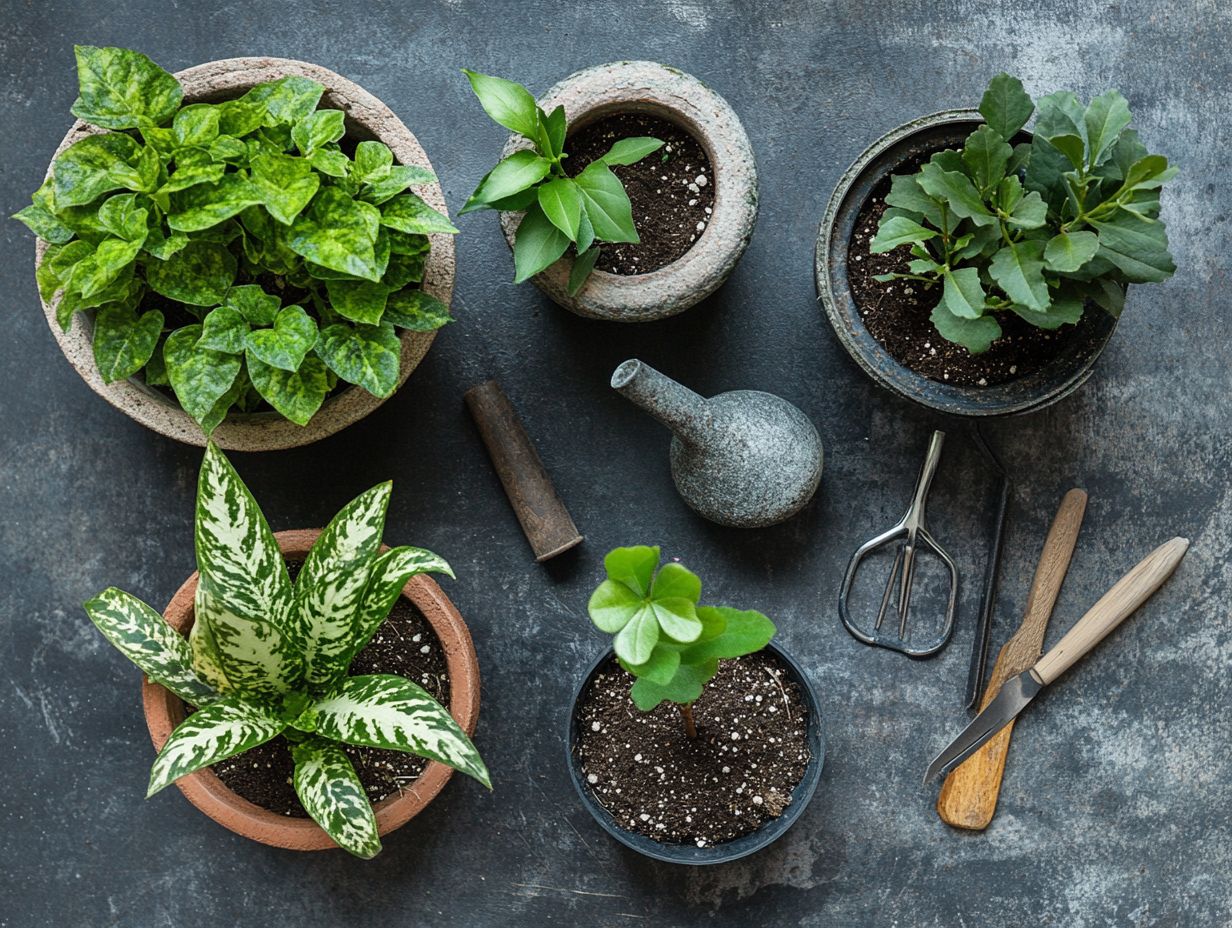
Natural remedies for soil problems present an eco-friendly way for you to maintain plant health and effectively manage various issues, ranging from organic insecticides for pest control to techniques that boost soil quality and drainage.
These solutions not only tackle immediate challenges in your gardening environment but also foster biodiversity and enhance the long-term health of the ecosystem. For example, using compost as a natural fertilizer enriches your soil with essential nutrients.
Additionally, tiny roundworms that help control pests keep pest populations in check without harming those helpful insects you want to protect. Implementing practices like changing where you plant different crops each season and planting crops that cover the soil can improve soil fertility and structure, reducing the risks associated with erosion and nutrient depletion.
By integrating these methods, you can cultivate a thriving garden that embodies sustainable gardening principles. Try these remedies today to see your garden thrive!
How to Maintain Healthy Soil for Indoor Plants?
Maintaining healthy soil for your indoor plants is essential for fostering optimal growth. Proper soil drainage and nutrient balance directly impact their health and vitality.
To achieve and sustain this, it’s important for you to adopt a well-rounded plan to soil maintenance. Regular soil testing is vital; it allows you to assess pH levels and nutrient content, enabling you to make timely adjustments that cater to your plants’ needs. Additionally, consider these 5 ways to promote healthy indoor plants for optimal growth.
Replenish nutrients using organic fertilizers or compost to enrich the soil and promote beneficial microbial activity. Ensuring adequate drainage is equally crucial; using pots with drainage holes prevents waterlogging, which can lead to root rot.
By considering these practices, you can cultivate a thriving environment for your indoor greenery.
What Are the Best Practices for Watering Indoor Plants?
Implementing the best practices for watering your indoor plants is crucial to avoiding the pitfalls of overwatering and underwatering. This ensures that your houseplants receive just the right amount of moisture for optimal growth.
Watering your indoor plants can be a fun and rewarding experience! By closely monitoring soil moisture levels and adjusting your watering schedule to meet the specific needs of each plant, you can cultivate a flourishing indoor environment.
Factors such as the type of plant, its growth stage, and the surrounding climate significantly influence how often and how much water is required. For example, succulents typically thrive on less water compared to ferns.
During the warmer months, your plants may demand more hydration. Regularly checking the soil with your finger or a moisture meter can provide invaluable insights, allowing you to adopt a tailored approach that caters to the unique requirements of your indoor garden. Additionally, being aware of 5 signs your indoor plant soil needs change can help you maintain optimal conditions for your plants.
How Often Should Indoor Plants Be Repotted?
Understanding how often to repot indoor plants is essential for preventing soil issues and ensuring their health. Repotting not only provides fresh nutrients but also creates the space necessary for growth.
Paying regular attention to your plants can help you recognize when it’s time to make this important transition. Look out for visible signs of distress, which may include:
- Roots pushing through drainage holes
- Stunted growth, even with consistent care
- Yellowing leaves that hint at nutrient depletion
Several factors influence how frequently you’ll need to repot, such as the type of plant, its growth rate, and the size of its current pot. To ensure optimal health, consider these best practices, including being aware of common soil issues affecting indoor plants:
- Select a pot that is only slightly larger than the existing one
- Use fresh, well-draining potting mix
- Gently disturb the roots to encourage new growth while minimizing shock
What Are the Benefits of Using Organic Soil for Indoor Plants?
Organic soil offers many benefits for your indoor plants. You’ll enjoy improved nutrient retention, healthier plants, and a significantly reduced risk of soil-borne diseases. These factors work together to enhance overall plant health.
This enriched environment nurtures robust root development and fosters beneficial microbial activity, allowing for better absorption of water and nutrients. Choosing organic soil means you use fewer chemical fertilizers, which can be harmful to the environment. Create a lively ecosystem in your pots and watch your plants thrive like never before!
Ultimately, this holistic approach not only cultivates flourishing plants but also promotes sustainable gardening practices.
How to Keep Indoor Plants Safe from Pets and Children?
Keeping your indoor plants safe from pets and children is crucial for maintaining a healthy environment, safeguarding them from curious hands and paws.
By strategically placing these green delights out of reach perhaps on higher shelves or in hanging planters you can effectively deter any accidental mishaps. Choosing non-toxic plant varieties adds an extra layer of security, allowing for a worry-free atmosphere where everyone can explore without concern.
Educating family members about the importance of gentle interactions with plant life fosters respect and curiosity, nurturing a shared understanding of how to coexist harmoniously with nature indoors.
Frequently Asked Questions
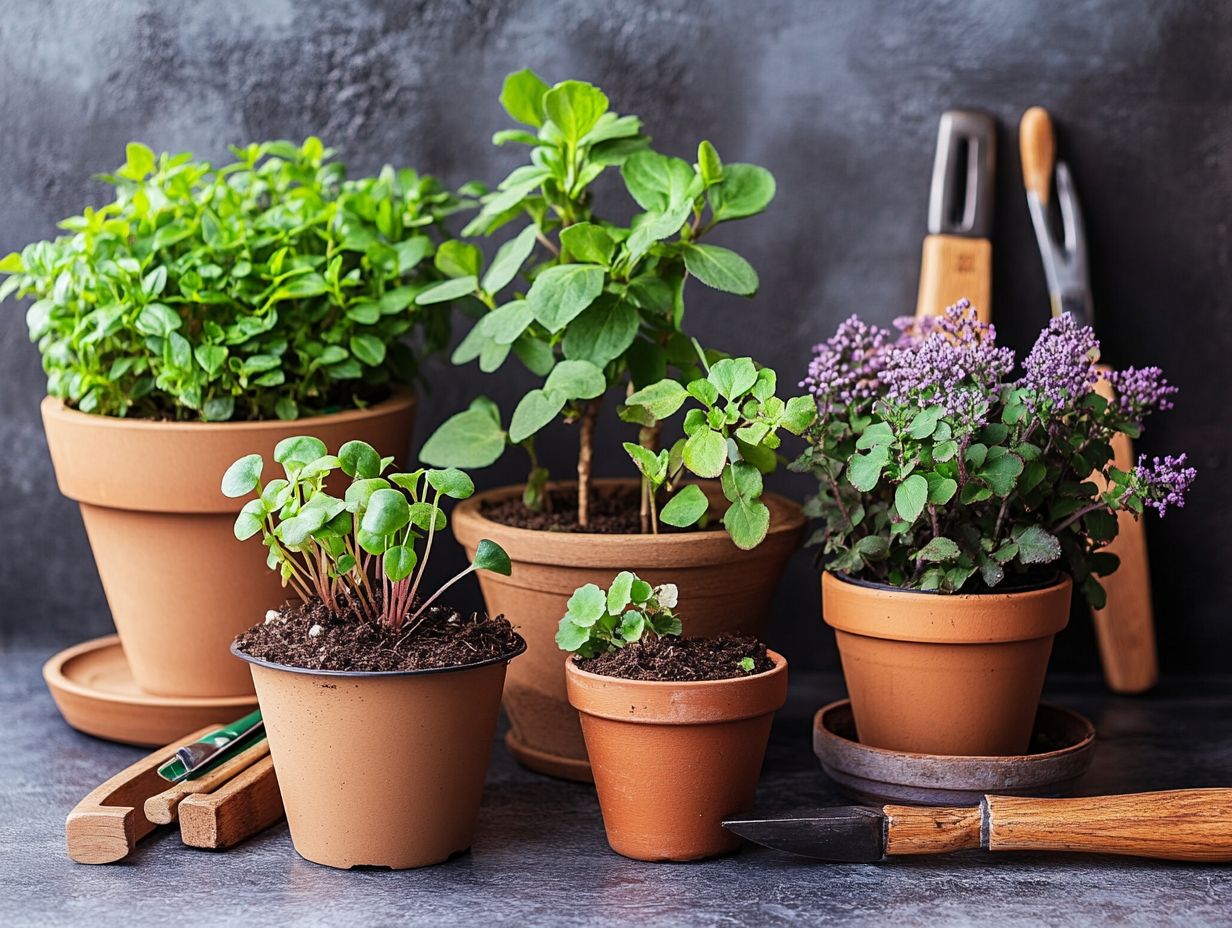
What are the 5 most common indoor plant soil problems?
- Overwatering
- Under-watering
- Compacted soil
- Nutrient deficiencies
- pH imbalance
How can I tell if my plant’s soil is overwatered?
Overwatered soil will appear wet and soggy, with a foul odor. The plant’s leaves may turn yellow and fall off, and you might notice mold or algae growth in the soil.
What can I do if my plant’s soil is compacted?
To solve compacted soil, gently aerate it with a fork or chopstick, being careful not to damage the plant’s roots. Alternatively, you can repot the plant with fresh, well-draining soil.
Can I use regular household soil for my indoor plants?
No, regular household soil is not suitable for indoor plants as it can contain harmful bacteria and pathogens. It is best to use a high-quality potting mix specifically designed for indoor plants.
How often should I fertilize my indoor plants?
It depends on the type of plant and the soil it is planted in. Generally, fertilize indoor plants every 2-4 weeks during their active growing season using a balanced fertilizer. Be cautious; too much fertilizer can lead to nutrient buildup and toxicity for the plant.
Why are my plant’s leaves yellow? Here s how to fix it!
If your plant’s leaves are turning yellow, it may indicate a nutrient deficiency. Try using a liquid fertilizer or adding organic matter to the soil for essential nutrients. Ensure the plant receives the right amount of sunlight and water, and monitor humidity levels. Be prepared for potential pest infestations from plant pests like aphids and spider mites.

